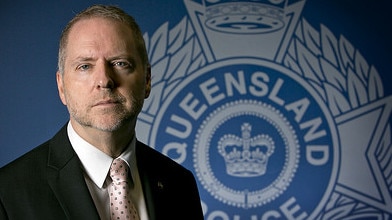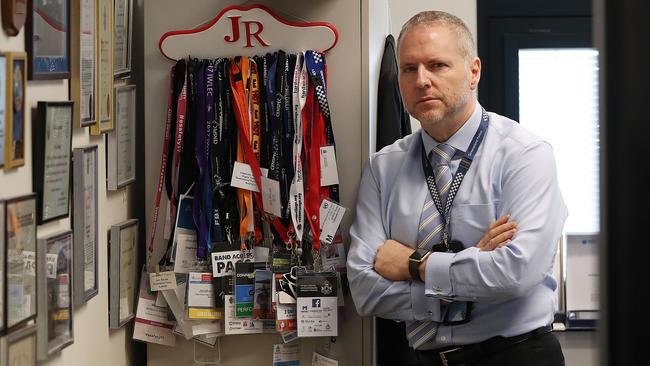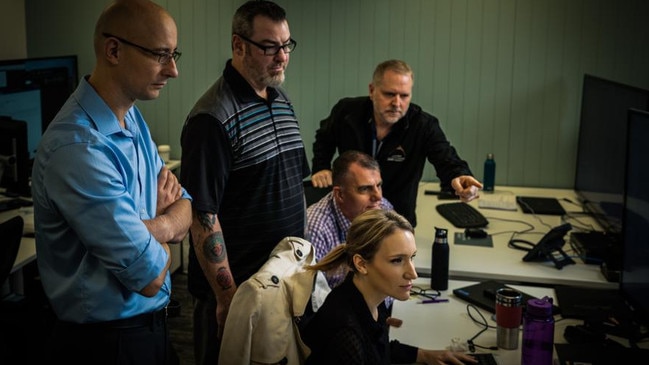Andrew Rule: Depraved ogres lurking beneath the internet’s sparkly surface
Commercial child abuse is metastasising like cancer via the internet and involves evil beyond belief. But this crack team of specialist investigators are saving thousands of children.

News
Don't miss out on the headlines from News. Followed categories will be added to My News.
When I first worked with Simon Nasht, he was a dashing young reporter in a dark suit and tie, dark hair and moustache — and a look of fierce concentration as he smashed out another Royal Show results story on a battered typewriter in the dingy press room under the Showgrounds grandstand.
It was 1979. Among the moleskins and straw and farm animals, young Nasht looked like Clark Kent channelling Bryan Ferry. But writing Show “yarns” laid the foundation of a brilliant career as a storyteller that would take him first to Canberra then to years based in London and New York before coming home.
Nasht’s name is on at least 40 documentaries, some made in tough places. Naive he isn’t.
But when fellow director Akhim Dev came to him in 2015 pitching an investigation of the borderless badlands of international child abuse, Nasht couldn’t quite believe it. Dev’s story of industrial-scale sexual abuse on the dark web seemed too far-fetched.
Turns out it wasn’t. Dev was right: the internet had enabled a secret army of tech-savvy deviants to weave a global web, exploiting technology to create a bottomless pit of depraved and distressing images ranging from cunningly-groomed teenagers to violated newborn babies.
One man sold guarantees of first access to images of an unborn child, publishing ultrasound scans of the foetus as proof of “ownership”.
Some dark web “boards” with thousands of followers specialise in sickening images of tiny babies being abused. Others peddle images of victims under three years old, abused specifically because toddlers do not have enough speech to describe what is happening.
Some will recall the arrest of the monstrous Australian paedophile Peter Scully, who sold “live views” of atrocities from his den in the Philippines. Scully raped and killed children on camera, his teenage girlfriend finding “street kids” to feed the beast.
Such depraved acts are abhorrent. But the fact there is a highly-organised market for it is worse. It normalises the horror — and means commercial child abuse is metastasising like cancer.

There have always been monsters, of course. In each state and most countries, there are sex offenders’ units like the one at Ararat, with inmates capable of the crimes Scully committed.
But more frightening than the few monsters in cells is that there are hundreds of men who rape children on camera because out there, around the world, are huge numbers of invisible adults who want to watch.
This is evil beyond belief. Which is why Nasht at first didn’t believe it. Also why investors and bodies who sponsor serious documentaries were too blinded by its repellent nature to grasp the scale of the crisis or the urgency needed to tackle it.
One reason that child abuse has become deeply entrenched online under the noses of corporations, governments and mainstream society is that no one wants to know about it. The instinct to ignore the unspeakable runs deep, which gives perverts the chance to get away with it.
But Dev persuaded Nasht and then Nasht joined forces with seasoned film producer Tony Wright, for whom surviving child abuse was personal. Between them they recruited backers, including SBS, Film Victoria and Screen Australia
The result is a restrained but chilling insight into a world that millions of deviates, and thousands of profiteers, have until now kept hidden deep in the dark web.
Nasht says it’s the most important story he has worked on in 30 years. But he’s not the hero of the piece. That part belongs mainly to a quietly-spoken Queensland policeman, Jon Rouse, who found his calling in the fight against the makers, promoters and consumers of child abuse material more than 20 years ago.
Det. Insp. Rouse isn’t your average copper. Talk to him for an hour then watch the documentary and you see someone formidably intelligent but not interested in showing off.
He played keyboard in bands supporting big touring acts and still plays with some of Brisbane’s hottest musicians. It’s a change from tracking the monsters of the dark web, a task a bit like playing simultaneous games of chess against invisible opponents for the highest stakes … the lives of abused children.

The son of a navy officer, growing up on naval bases, young Rouse started work in a Brisbane bank in the 1980s. But after getting held up twice — he followed one robber into the street to get a better description — he joined the police.
Rouse did the usual street policing but showed natural ability at handling the then new-fangled computers. He took a sergeant’s vacancy in the force’s sexual assault and child abuse unit in 1996 to get promotion, not because of burning zeal. The zeal would follow.
A quarter century later, Rouse is known by law enforcement agencies worldwide for building a crack team of specialist investigators in Brisbane. He recruited several from overseas to battle the ogres lurking beneath the internet’s sparkly surface.
It is named Task Force Argos and it punches above its weight, leading to the birth of the Australian Centre to Counter Child Exploitation. The A-team includes former UK policeman Paul Griffiths, Adele Desirs from France, American Scott Anderson and Canadian Warren Bulmer.
All of them have been doing it long enough to see the mushroom cloud of child abuse material (they never call it “child pornography” because that implies consent) that has erupted alongside technical advances enabling easy and instant internet access on portable screens.
The rise and rise of the “selfie” since 2013 signals a corresponding rise in the use of social media to abuse children by tapping the secret paedophile tendencies of millions of men around the world who might otherwise not have acted on their impulses.
One of Task Force Argos’s star investigators is Griffiths, a former Manchester cop who started his career in paedophile-hunting by seizing “dirty pictures” and the odd creep hanging around playgrounds.
The difference between that seedy scene in the early 1990s and commercialised child abuse on the internet now is jaw-dropping. Griffiths has seen it all.
“If one human being’s done it to another human being, then I’ve seen a photograph or a video of it happening,” he says.
As head of the Argos victim identification unit since arriving in 2009, Griffiths is vital to their mission of rescuing abused children. His photographic memory is one reason that Argos (and allied agencies) pinpoint tiny details that lead to finding and freeing a child from sexual bondage.

A standout example is Girl One, a young child abused on camera year after year. The Argos team worked out she was in America and eventually handed its set of clues to the FBI.
In one set of images was a distinctive bedspread. That and light fittings and a couch suggested a hotel or room. There was another clue: a brightly-coloured car door.
The car was identified as a Pontiac Aztec in “Sunburst Orange”. A common model and colour. But American investigator Dawn Ego checked companies that supplied hotel chains — and one of them linked the bedspread to a motel in northern Georgia.
The motel manager confirmed the bedspread, couch and light fittings. Even better, she recalled the driver of an orange Aztec who’d made her feel uncomfortable.
And that is how the Australian team helped save Girl One, nailing the man who had abused her and put the images online for five years. Her father.
Griffiths and the team are experts at the sort of painstaking clue hunting that counter-terrorism specialists use to track bombers and assassins. A glimmer of an eye here, a reflection there, a bar code, a glimpse of a road sign — it can all be used to crack the code.
But arrests are “bycatch”. The main aim, says Jon Rouse, is to save the children. His team has rescued thousands.
That’s why they titled the documentary The Children in the Pictures. It’s on SBS from October 24.
More Coverage
Originally published as Andrew Rule: Depraved ogres lurking beneath the internet’s sparkly surface





